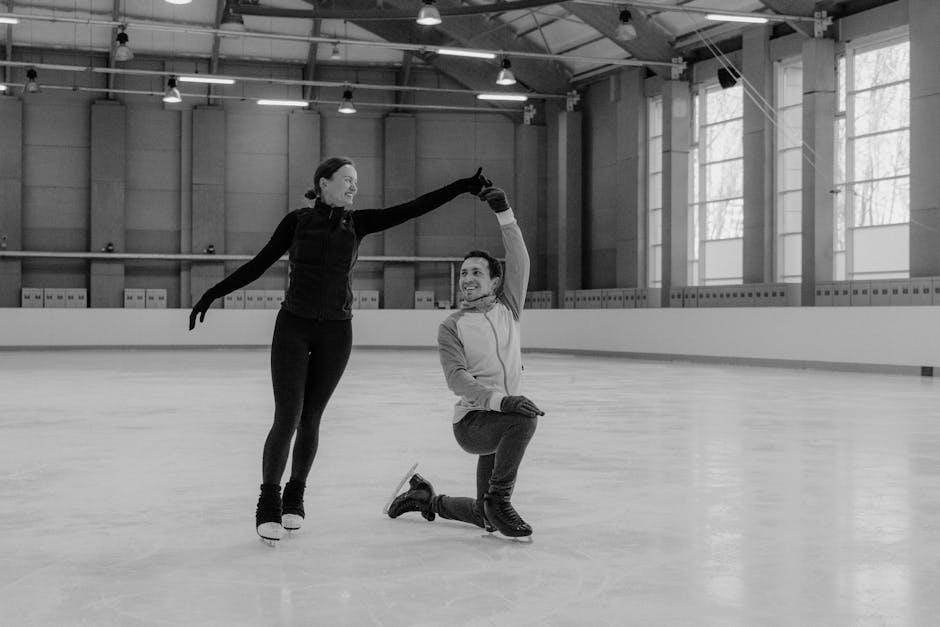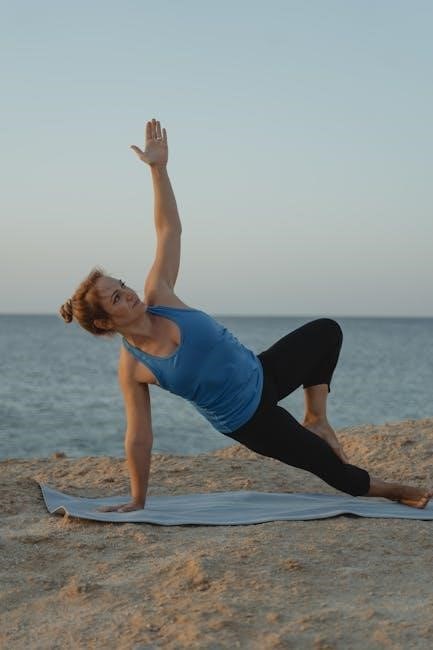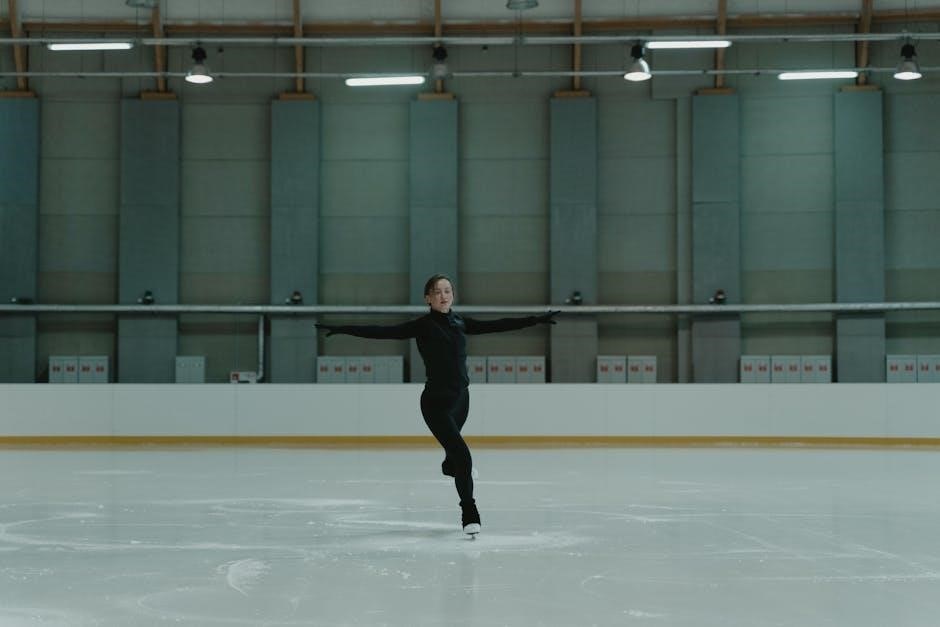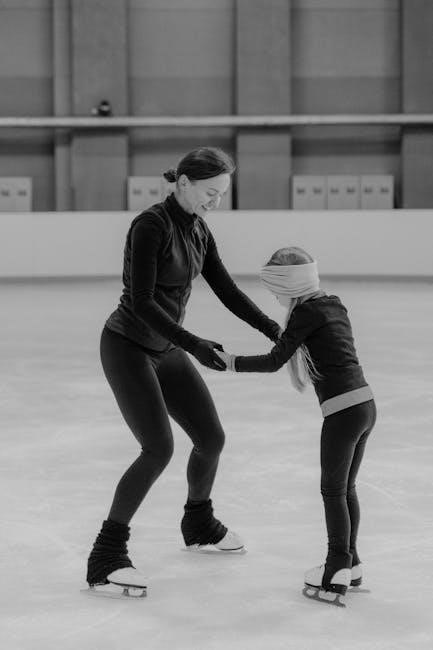Rotator cuff tendonitis is inflammation of the tendons in the shoulder‚ often caused by repetitive strain or overuse. It leads to pain and limited mobility‚ making daily activities challenging. Exercise plays a crucial role in recovery‚ with stretching and strengthening routines tailored to restore shoulder function. Printable PDF guides are widely recommended for structured rehabilitation programs‚ ensuring safe and effective treatment.
1.1 Definition and Overview
Rotator cuff tendonitis refers to inflammation of the tendons in the shoulder‚ often caused by repetitive movements or overuse. It leads to pain‚ limited mobility‚ and weakness. Exercise programs‚ including stretching and strengthening routines‚ are essential for recovery. Printable PDF guides‚ such as those from Medbridge‚ provide structured routines to enhance rehabilitation. These resources emphasize avoiding pain during exercises and tailored approaches to prevent further injury‚ ensuring a safe and effective recovery process for individuals with rotator cuff tendonitis.
1.2 Common Causes of Rotator Cuff Tendonitis
Rotator cuff tendonitis is often caused by repetitive movements‚ overuse‚ or prolonged strain on the shoulder muscles. Activities requiring frequent overhead motions or heavy lifting can lead to inflammation. Wear and tear over time‚ poor posture‚ or sudden injuries may also contribute. Age-related degeneration can weaken tendons‚ increasing susceptibility. Understanding these causes is crucial for developing targeted exercises and preventive strategies to address the condition effectively.
1.3 Symptoms and Diagnosis
Common symptoms of rotator cuff tendonitis include shoulder pain‚ especially at night or with overhead movements‚ weakness‚ and limited range of motion. Pain may radiate down the arm and worsen with activity. Diagnosis involves physical exams to assess strength and mobility‚ often complemented by imaging tests like X-rays or MRIs to rule out tears. Early identification is critical for effective treatment‚ ensuring exercises and therapies can address the condition before it progresses‚ reducing pain and restoring function.

The Importance of Exercise in Treating Rotator Cuff Tendonitis
Exercise is essential for improving shoulder function and reducing pain in rotator cuff tendonitis. It strengthens muscles‚ restores mobility‚ and prevents further injury‚ aiding in recovery. Printable PDF guides provide structured routines‚ ensuring safe and effective treatment. Regular exercises promote long-term shoulder health and function‚ making them a cornerstone of rehabilitation.
2.1 How Exercise Helps in Recovery
Exercise promotes blood flow‚ reducing inflammation and repairing damaged tendons. It strengthens shoulder muscles‚ improving stability and reducing strain on the rotator cuff. Gentle movements restore flexibility‚ while controlled exercises enhance tendon elasticity and strength. Over time‚ this leads to improved joint lubrication and muscle balance‚ reducing pain and preventing future injuries. Consistent exercise also reduces reliance on pain medications‚ enabling better mobility and functionality in daily activities.
2.2 Goals of Rotator Cuff Exercises
The primary goals of rotator cuff exercises are to reduce pain‚ enhance strength‚ restore mobility‚ and improve functional movement. These exercises aim to promote tendon healing‚ improve joint stability‚ and prevent future injuries. By targeting specific muscles‚ they help restore proper shoulder mechanics and posture. Consistent practice also boosts overall shoulder health‚ enabling patients to return to daily activities and sports safely. Tailored routines ensure a gradual and effective recovery.
2.3 Role of PDF Guides in Exercise Programs
PDF guides play a crucial role in rotator cuff tendonitis exercise programs by providing structured‚ accessible‚ and visual instructions. They often include detailed diagrams‚ step-by-step routines‚ and progression plans. These guides ensure consistency and accuracy in performing exercises‚ reducing the risk of improper form. They also serve as portable resources‚ allowing individuals to follow their routines anywhere. PDF guides are particularly beneficial for tracking progress and maintaining motivation throughout the recovery journey.

Safe Exercises for Rotator Cuff Tendonitis
Safe exercises focus on promoting healing and mobility without causing further injury. They include low-impact movements like light stretching and controlled strengthening to restore shoulder function gradually.
3.1 Stretching Exercises
Gentle stretching is essential to improve shoulder mobility and reduce stiffness. Common stretches include the cross-body stretch for the supraspinatus and infraspinatus muscles‚ and the seated forward fold to stretch the entire shoulder region. These exercises should be performed slowly and held for 20-30 seconds to maximize effectiveness. Avoid bouncing or forcing beyond a comfortable range to prevent further irritation. Incorporating wall slides can also help improve scapular mobility and reduce tension in the rotator cuff muscles.
3.2 Strengthening Exercises
Strengthening exercises are crucial for rebuilding rotator cuff stability and function. Scapular wall slides and resistance band external rotations target key muscles without excessive strain. Planks with shoulder taps and arm raises in neutral positions also enhance strength. Side-lying shoulder external rotations are effective for isolating the infraspinatus muscle. These exercises should be performed with light resistance and controlled movements to avoid aggravation. Progressing gradually ensures proper healing and prevents re-injury‚ while improving overall shoulder stability and resilience.
3.3 Low-Impact Activities to Avoid Aggravation
Engaging in low-impact activities like swimming‚ water aerobics‚ or cycling can help maintain mobility without overloading the rotator cuff. These activities promote blood flow and strengthen surrounding muscles gently. Avoid repetitive overhead movements or heavy lifting‚ even in low-impact exercises. Opt for seated or standing exercises with minimal arm elevation. Always prioritize pain-free movements to prevent further irritation. Consulting a physical therapist can help tailor activities to individual needs and ensure safe progression.

Exercises to Avoid During Recovery
Avoid heavy lifting‚ overhead movements‚ and high-impact sports during recovery. These exercises can strain the rotator cuff tendons‚ leading to further injury. Prioritize rest and pain-free activities.
4.1 High-Impact Activities
High-impact activities‚ such as running‚ jumping‚ or contact sports‚ should be avoided during recovery. These movements place excessive stress on the rotator cuff‚ potentially causing further damage. Activities that involve sudden stops‚ quick changes in direction‚ or repetitive overhead motions can aggravate the tendons. Avoiding these will help prevent re-injury and allow the tendons to heal properly. Always prioritize low-impact exercises that promote recovery without putting excessive strain on the shoulder.
4.2 Heavy Lifting and Overhead Movements
Heavy lifting and overhead movements can exacerbate rotator cuff tendonitis by placing additional strain on the already inflamed tendons. Activities like carrying heavy objects‚ reaching above shoulder level‚ or repetitive overhead motions should be avoided. These movements can lead to increased inflammation and slow down the healing process. It’s important to minimize such actions to protect the shoulder and promote recovery. Instead‚ focus on gentle‚ controlled exercises that strengthen without strain.
4.3 Exercises That Cause Pain
Exercises that cause pain should be avoided‚ as they may worsen rotator cuff tendonitis. Activities that involve direct stress on the inflamed tendons‚ such as deep shoulder presses or high-impact movements‚ can exacerbate symptoms. If an exercise triggers sharp pain or discomfort‚ it should be stopped immediately. Consulting a healthcare professional or physical therapist can help identify safe alternatives. Modifying exercises to avoid pain is crucial for proper healing and preventing further damage to the rotator cuff.

Creating a Personalized Exercise Plan
A personalized plan involves assessing shoulder mobility‚ setting realistic goals‚ and incorporating exercises tailored to individual needs‚ ensuring safe and effective recovery from rotator cuff tendonitis.
5.1 Assessing Your Current Shoulder Mobility
Assessing shoulder mobility involves evaluating range of motion‚ strength‚ and pain levels. A healthcare professional or physical therapist can perform a visual assessment and manual tests to determine current limitations. This step helps identify which exercises are safe and suitable for your condition‚ ensuring the personalized plan addresses specific weaknesses and avoids aggravating the injury. Accurate assessment is crucial for creating an effective and injury-free exercise routine tailored to your needs.
5.2 Setting Realistic Goals for Recovery
Setting realistic goals is essential for effective recovery from rotator cuff tendonitis. Start by creating a timeline for progress‚ considering the severity of your injury. Goals should be specific‚ measurable‚ and achievable‚ focusing on regaining strength and mobility. Consult with a physical therapist to tailor objectives to your needs. Define milestones‚ such as pain reduction or improved range of motion‚ and track progress regularly. Realistic goals keep you motivated and ensure a steady‚ injury-free recovery journey.
5.3 Incorporating PDF Guides into Your Routine
Incorporating PDF guides into your routine provides structured‚ accessible plans for rotator cuff recovery. These guides often include detailed exercises‚ diagrams‚ and progress trackers. They allow for consistent practice at home or while traveling. PDF guides also offer visual aids and step-by-step instructions‚ ensuring proper form and safety. By following these guides‚ you can stay motivated and organized‚ making steady progress toward healing. Regular use helps maintain discipline and consistency in your rehabilitation journey.

Pain Management During Exercises
Effective pain management during exercises involves monitoring discomfort‚ using ice or heat therapy‚ and avoiding movements that exacerbate symptoms. Prioritize gentle‚ controlled motions to prevent further irritation and promote healing.
6.1 Monitoring Pain Levels
Monitoring pain levels during rotator cuff exercises is crucial for safe recovery. Use a pain scale to assess discomfort‚ aiming for mild to moderate pain (2-5/10). Avoid sharp or stabbing pain‚ as it may indicate overstrain. Pay attention to pain type—dull‚ achy pain is typically manageable‚ while acute pain signals a need to stop. Adjust exercises immediately if pain increases‚ ensuring activities remain therapeutic rather than harmful. This balance prevents setbacks and promotes gradual healing.
6.2 When to Stop an Exercise
Stop an exercise immediately if sharp or stabbing pain occurs‚ as this indicates potential damage. Numbness‚ tingling‚ or weakness in the arm or shoulder are red flags to cease activity. If pain persists beyond mild discomfort or worsens after rest‚ discontinue the exercise. Avoid movements that trigger significant pain‚ as they may exacerbate the injury. Consult a physical therapist or doctor if pain recurs or intensifies‚ ensuring proper adjustments to your routine and preventing further harm.
6.3 Modifying Exercises for Comfort
Modify exercises to avoid discomfort by reducing the range of motion or intensity. Use assistive devices like resistance bands or pillows for support. Substitute painful movements with alternate exercises that target the same muscles without strain. For example‚ swap overhead exercises for shoulder blade squeezes. Focus on controlled‚ slow movements to minimize stress on the rotator cuff. Adjusting your technique or switching to low-impact activities like swimming can enhance comfort while maintaining progress in recovery.

Advanced Techniques for Recovery
Advanced techniques include resistance training‚ yoga‚ and Pilates to enhance strength and flexibility. Incorporate assistive devices for support and progress exercises gradually to promote healing and mobility.
7.1 Progressing to Resistance Training
Progressing to resistance training involves introducing light weights or resistance bands to strengthen the rotator cuff muscles. Start with gentle resistance and gradually increase intensity. Focus on controlled movements to avoid strain. Incorporate exercises like resisted shoulder rotations and scapular pushes. Proper form is crucial to prevent further injury. Resistance training helps rebuild muscle strength and stability‚ promoting long-term recovery. Always consult a physical therapist to tailor resistance exercises to your specific needs and progress safely.
7.2 Incorporating Yoga or Pilates
Incorporating yoga or Pilates into your routine can enhance flexibility‚ strength‚ and body awareness. These practices focus on controlled movements that stabilize the shoulder joint without overstraining. Modified poses and exercises can target the rotator cuff muscles gently. Yoga and Pilates improve posture and core strength‚ which supports shoulder health. Always consult a therapist to tailor exercises to your injury. These practices promote healing and prevent future injuries by addressing muscle imbalances and improving overall mobility.
7.3 Using Assistive Devices for Support

Assistive devices like slings‚ braces‚ and ergonomic supports can aid in recovery. Slings immobilize the arm‚ reducing strain‚ while braces provide stability during exercises. These devices are especially helpful in the acute phase to prevent further injury. However‚ they should complement‚ not replace‚ a structured exercise program. Gradually reducing reliance on these devices as strength improves is key. Always consult a healthcare professional to choose the right device for your condition.

Role of Physical Therapy
Physical therapy provides professional guidance‚ personalized treatment plans‚ and advanced techniques to enhance recovery from rotator cuff tendonitis‚ ensuring safe and effective progress.
8.1 Benefits of Professional Guidance
Professional guidance in physical therapy offers personalized treatment plans tailored to individual needs‚ enhancing recovery efficiency and effectiveness. Therapists provide expert oversight‚ ensuring exercises are performed correctly to maximize healing and prevent further injury. They also offer advanced techniques and continuous monitoring‚ adjusting plans as needed. This customized approach fosters faster progress and helps patients return to normal activities pain-free‚ making it a vital component of rotator cuff tendonitis rehabilitation.
8.2 Customizing Exercises with a Therapist
A therapist assesses individual shoulder mobility and strength to tailor exercises‚ ensuring they address specific weaknesses and promote recovery. They adjust routines based on progress‚ incorporating stretches and strengthening techniques. This personalized approach targets the root cause of tendonitis‚ enhancing effectiveness. Therapists also integrate PDF guides into customized plans‚ providing clear instructions for home exercises. Regular adjustments ensure the program evolves with the patient’s recovery‚ maximizing results and minimizing setbacks.
8.4 Tracking Progress and Adjustments
Regularly monitoring progress ensures exercises remain effective and safe. A therapist may use documentation or PDF guides to track improvements‚ adjusting routines as needed. Adjustments prevent plateaus and tailor exercises to individual recovery stages. This personalized approach optimizes healing and avoids overexertion. Continuous assessment ensures exercises evolve with the patient’s progress‚ promoting steady recovery without setbacks.

Preventing Future Injuries
Preventing future injuries involves consistent exercise‚ maintaining shoulder strength‚ and proper posture. Using rotator cuff tendonitis exercises PDF guides ensures structured routines to avoid recurrence.
9.1 Maintaining Shoulder Strength
Maintaining shoulder strength is crucial for preventing future injuries; Regular exercises targeting the rotator cuff and surrounding muscles help improve stability and reduce strain. Incorporating resistance bands‚ light weights‚ and bodyweight exercises into your routine can enhance muscle endurance. Consistency is key‚ as weakened shoulders are more prone to reinjury. Using a rotator cuff tendonitis exercises PDF guide ensures you follow a structured program tailored to strengthen the shoulder muscles effectively‚ promoting long-term joint health and functionality.
9.2 Improving Posture and Ergonomics
Improving posture and ergonomics plays a vital role in preventing rotator cuff strain. Poor posture can lead to uneven shoulder alignment‚ increasing the risk of injury; Adjusting your workspace‚ such as monitor height and chair position‚ can reduce strain. A rotator cuff tendonitis exercises PDF often includes tips for proper ergonomics and stretches to maintain alignment. By addressing these factors‚ you can reduce long-term shoulder stress and minimize the likelihood of future injuries.
9.3 Avoiding Repetitive Strain
Avoiding repetitive strain is essential for preventing future rotator cuff injuries. Repetitive overhead movements or repetitive lifting can exacerbate tendonitis. A rotator cuff tendonitis exercises PDF often emphasizes the importance of varying tasks and taking regular breaks. Incorporating rest periods and modifying activities can significantly reduce strain. By identifying and limiting repetitive motions‚ individuals can protect their shoulders and promote long-term healing and strength.
Consistency in exercise and proper care are key to recovery. Consult professionals for guidance and use rotator cuff tendonitis exercises PDF for structured routines and additional resources.
10.1 Summary of Key Points
Rotator cuff tendonitis exercises are foundational for recovery‚ focusing on stretching‚ strengthening‚ and low-impact activities. Avoid high-impact movements and heavy lifting to prevent aggravation. PDF guides provide structured routines‚ ensuring proper form and progression. Professional guidance enhances safety and effectiveness‚ while consistency in exercise routines promotes long-term healing. By combining these strategies‚ individuals can achieve significant improvement and reduce the risk of future injuries. Recovery requires patience‚ dedication‚ and a well-rounded approach tailored to individual needs.
10.2 Encouraging Consistency in Exercise
Consistency is key to healing and preventing future injuries. Set realistic goals and track progress to stay motivated. Use a rotator cuff tendonitis exercises PDF to guide daily routines and set reminders. Incorporate exercises into your schedule to build a habit. Celebrate small milestones to stay committed. Regular practice strengthens muscles‚ improves mobility‚ and supports long-term recovery. Stay consistent to achieve lasting results and reduce the risk of recurrence.
10.3 Accessing Additional Resources
To further support recovery‚ explore additional resources like rotator cuff tendonitis exercises PDF guides. These downloadable materials often include detailed routines‚ diagrams‚ and progression plans. Visit reputable orthopedic or sports medicine websites for trusted resources. Online forums and communities can also provide tips and shared experiences. Utilize these tools to enhance understanding and stay motivated throughout the recovery journey. Accessing diverse resources ensures a well-rounded approach to healing and strength rebuilding.
